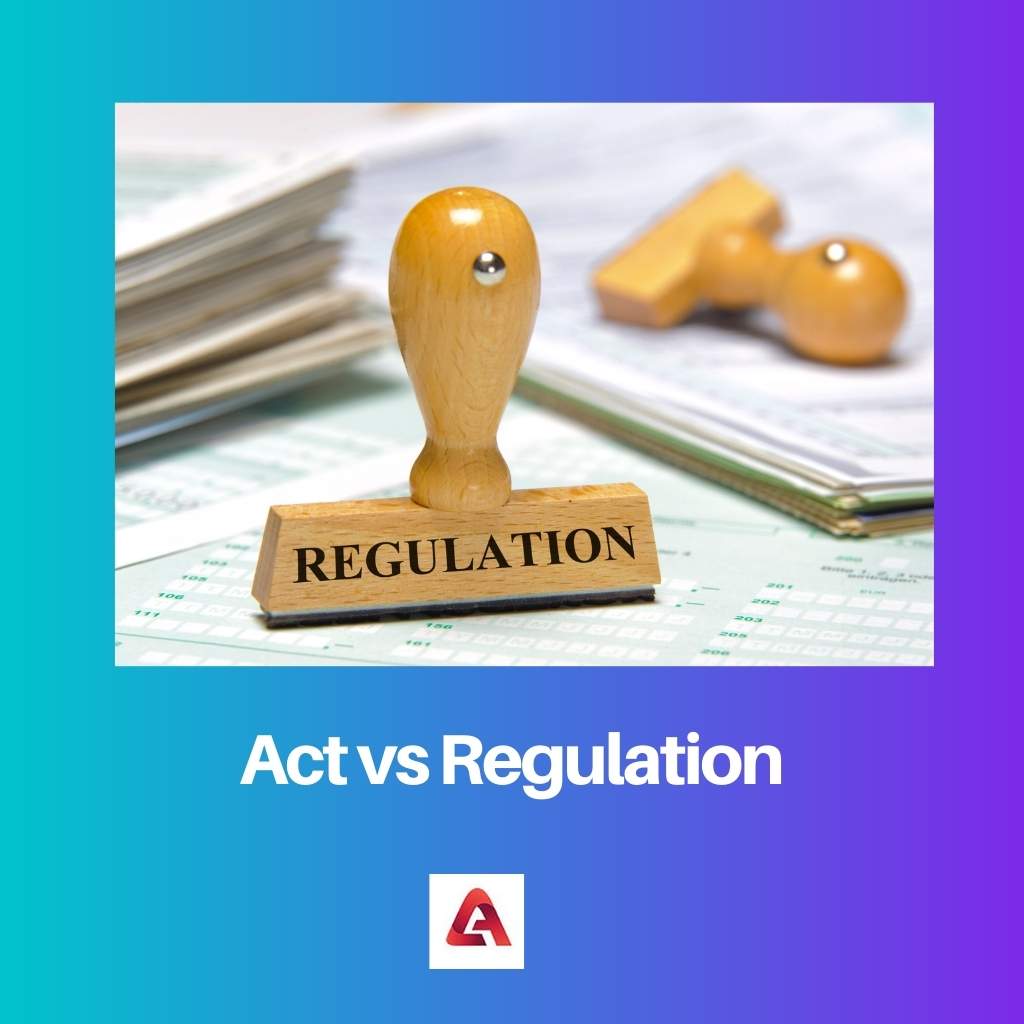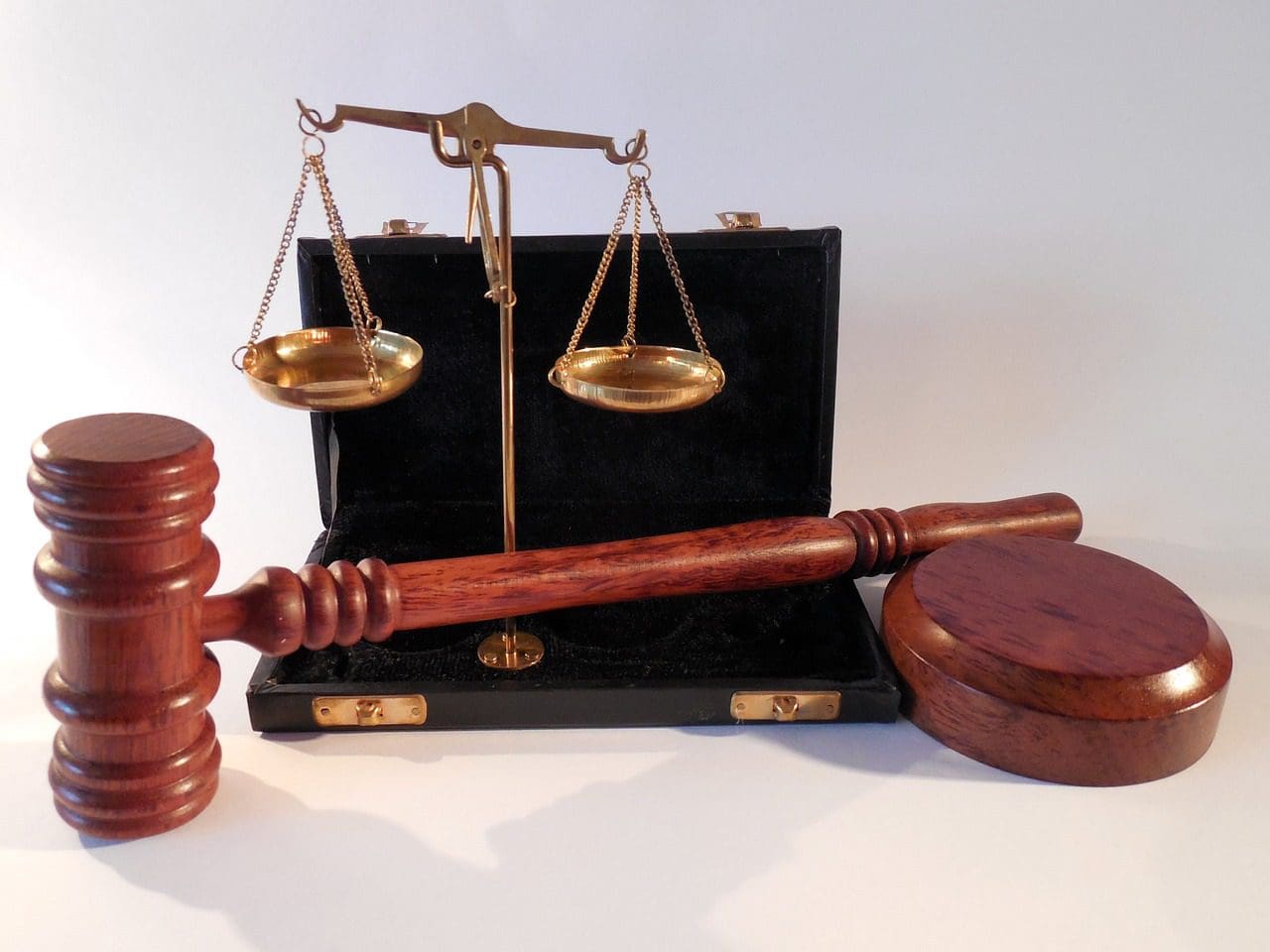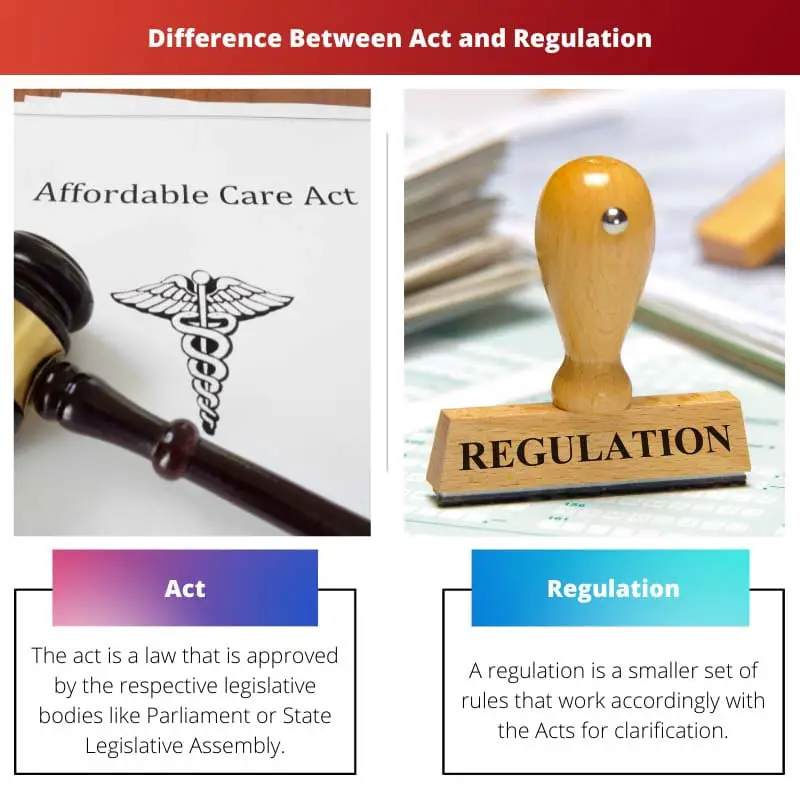Every county has government bodies and organizations that are responsible for passing different types of legislation. These legislations are practised and observed all over the country by specific groups of individuals.
Every person in the country who lives there or comes to visit there has to follow those legislations. Act and regulation are some of the commonly-known legislations.
Key Takeaways
- Acts are legislative documents enacted by a governing body, while regulations are rules created by an administrative agency to enforce acts.
- Acts provide the legal framework and broad guidelines, whereas regulations outline specific procedures, requirements, and conditions.
- Regulations must adhere to the provisions of the act they support, ensuring consistency and alignment with the original legislative intent.
Act vs Regulation
Acts (known as acts of parliament) are laws that are passed, and regulations (subsidiary legislation) are guidelines that dictate how the legal provisions of the act should be followed. Acts are approved by the legislative assembly, while regulations are approved by the Cabinet.

When a law is passed by the legislature, it is entitled as an Act. There is a procedure for making an Act.
When a bill introduced by a member of parliament or the government is passed by both houses of parliament, it is presented to the President for his concern.
When the President gives his assent, the bill then turns into an Act.
On the other hand, regulation is approved by a group of individuals based on a passed Act. Regulations are the subsidiary legislation that defines the essence of the Acts.
It also provides guidelines that show the way the Act needs to be implemented.
Comparison Table
| Parameters of Comparison | Act | Regulation |
|---|---|---|
| Definition | The act is a law that is approved by the respective legislative bodies like Parliament or State Legislative Assembly. | A regulation is a smaller set of rules that work accordingly with the Acts for clarification. |
| Procedure | When a bill is introduced by the government or a member of Parliament gets accepted by both of the two houses of the parliament, it is then presented to the President for acceptance. When the President gives his assent the bill is turned into an Act. | Regulations are the specific requirement within the legislation. It is made by the regulatory bodies for implementing laws appropriately. |
| Enacted by | Acts are enacted by legislative bodies. | Regulations are enacted by subsidiary legislation. |
| Type | Acts are the parent law, known as Acts of Parliament. | Reflections are subordinate and supplement in nature. |
| Publishing process | Acts are published as a single document and are available to the public. | Regulations are published in the Government Gazette. |
What is Act?
When a law is passed by the legislature, it is entitled as an Act. This legislative body may be nationwide or state-wide.
The Act is the provision enacted by the legislature or government for the public to understand the specific meaning of certain circumstances, how they are expected to behave or react in a certain situation,
and the importance of following the Act.
There is a procedure for making an Act. Firstly, a bill is introduced by the government or a member of Parliament and sent to get voted by both of the houses of the Parliament.
If the bill passes in both houses, then it is sent to the President of the country or the Governor of the state for approval. Once it was accepted, the bill turned into an Act, which is a constitutional plan.
Acts are meant to deal with different aspects of the laws. Some Acts are substantial, while some are procedural, and some are private, while some are public.

What is Regulation?
Regulation is approved by a group of individuals based on a passed Act. Regulations are the subsidiary legislation that defines the essence of the Acts.
It also provides guidelines that show the way the Act needs to be implemented.
In industries, regulations are specific formal rules that organizations and their workers follow. Therefore two main forms of regulation- self-regulation and government regulation.
Self-regulation is the regulations that are followed by an individual, or a business where they have control over how it fulfils the legislative requirements, and government regulation is the natural extension of legislation.
Regulations are enforced by the regulators. They are produced by the regulating authority.
They are not interfered with by the President or the head of the state. They are either enforced internally or externally.
Regulations are published in the official or Government Gazette.

Main differences Between Act and Regulation
- When a law is passed by the legislature, it is entitled as an Act. On the other hand, a regulation is a smaller set of rules that work accordingly with the acts for clarification.
- When the government introduces a bill or a member of Parliament gets accepted by both the two houses of the parliament, it is then presented to the President for acceptance. When the President gives his assent, the bill is turned into an Act. On the other hand, Regulations are the specific requirement within the legislation. The regulatory bodies make it for implementing laws appropriately.
- Acts are published as a single document and are available to the public. On the other hand, regulations are not passed before the Parliament houses, and regulations are published in the government gazette.
- Acts are enforced by legislative bodies, whereas regulations are enacted by subsidiary bodies.
- The Act is the parent law, whereas the regulations are subordinate and supplement in nature.

- https://books.google.co.in/books?hl=en&lr=&id=zGI3BAAAQBAJ&oi=fnd&pg=PR7&dq=definition+of+An+Act+in+Law+&ots=SbP13zxszV&sig=1R-jIwFYurqM0aXbTloHhDcYl7I&redir_esc=y
- https://books.google.co.in/books?hl=en&lr=&id=ngykkvYDzy0C&oi=fnd&pg=PR9&dq=what+is+regulation+&ots=Tdkax_kct1&sig=CeZ-WYBI1ruoJfJmzjSV_MOcz1Q&redir_esc=y

The procedures involved in making Acts and regulations, as well as the legal authority of these legislative documents, are essential components of a robust legal system.
Indeed, the enactment of Acts and regulations is a critical part of any legal system, providing the necessary framework for governance and public compliance.
Understanding the difference between Acts and regulations is essential in comprehending the legal system. Acts are broad laws, and regulations outline specific procedures and requirements.
Absolutely, Acts and regulations work in tandem to create a comprehensive legal structure that ensures transparency and consistency in the legal system.
The comparison table provided effectively highlights the distinctions between Acts and regulations, making it easier to comprehend.
The contrast between Acts and regulations and their specific roles in legislative structures emphasizes the complexity and significance of the legal system in governing a country.
The comprehensive comparison table effectively presents the differences between Acts and regulations, providing clarity on their unique functions within the legal system.
Absolutely, the distinction between Acts and regulations is crucial in understanding the legal framework and the processes that underpin it.
The procedures involved in the enactment of Acts and regulations are detailed and meticulous, reflecting the importance of legal processes in governance and public compliance.
The requirement for approval from the President for Acts emphasizes the gravity and authority of these legislative documents.
The significance of the legislative procedures in creating Acts and regulations cannot be understated. It’s a fundamental aspect of a country’s legal system.
The process of enacting Acts and regulations follows a rigorous and comprehensive approach to ensure the legality and relevance of the legislation.
The distinction between self-regulation and government regulation provides insight into the different approaches of ensuring compliance with legal requirements.
Absolutely, the stringent processes involved in the enactment of Acts and regulations are essential for establishing legal authority and clarity.
The legislative process involved in creating and enacting Acts and regulations is a key aspect of maintaining order, transparency, and adherence to the law within a country.
The detailed comparison between Acts and regulations sheds light on their distinct roles in structuring the legal framework of a country and ensuring legal compliance.
Understanding the main differences between Acts and regulations facilitates a deeper understanding of the legal framework and the roles of various legislative bodies.
The process of law-making involving Acts and regulations highlights the structured and meticulous approach required in legislative decision-making.
Absolutely, the comparison between Acts and regulations underlines their unique contributions to the legal system, ensuring clarity and consistency in law implementation.
The distinction between Acts and regulations as parent law and subordinate legislation respectively sheds light on their complementary roles in shaping the legal framework.
The relationship between Acts and regulations is akin to a blueprint and its detailed specifications, ensuring cohesive and consistent legal guidelines.
Acts and regulations, as the two pillars of the legal system, ensure the proper functioning and governance of a country through clear rules and guidelines.
The publishing process of Acts and regulations contributes to transparency and accessibility for the public, ensuring widespread awareness of the legal framework.
Indeed, understanding the role of Acts and regulations is pivotal in comprehending how laws are structured and implemented within a society.
The legislative process is quite complex yet essential to ensure the implementation of laws. Acts and regulations play a crucial role in shaping the legal framework of a country.
I agree, the process of passing bills and obtaining presidential assent for bills requires a lot of scrutinization and consideration of different aspects.
The distinction between Acts and regulations is clear. Acts provide the legal foundation, while regulations offer specific guidelines for implementation.